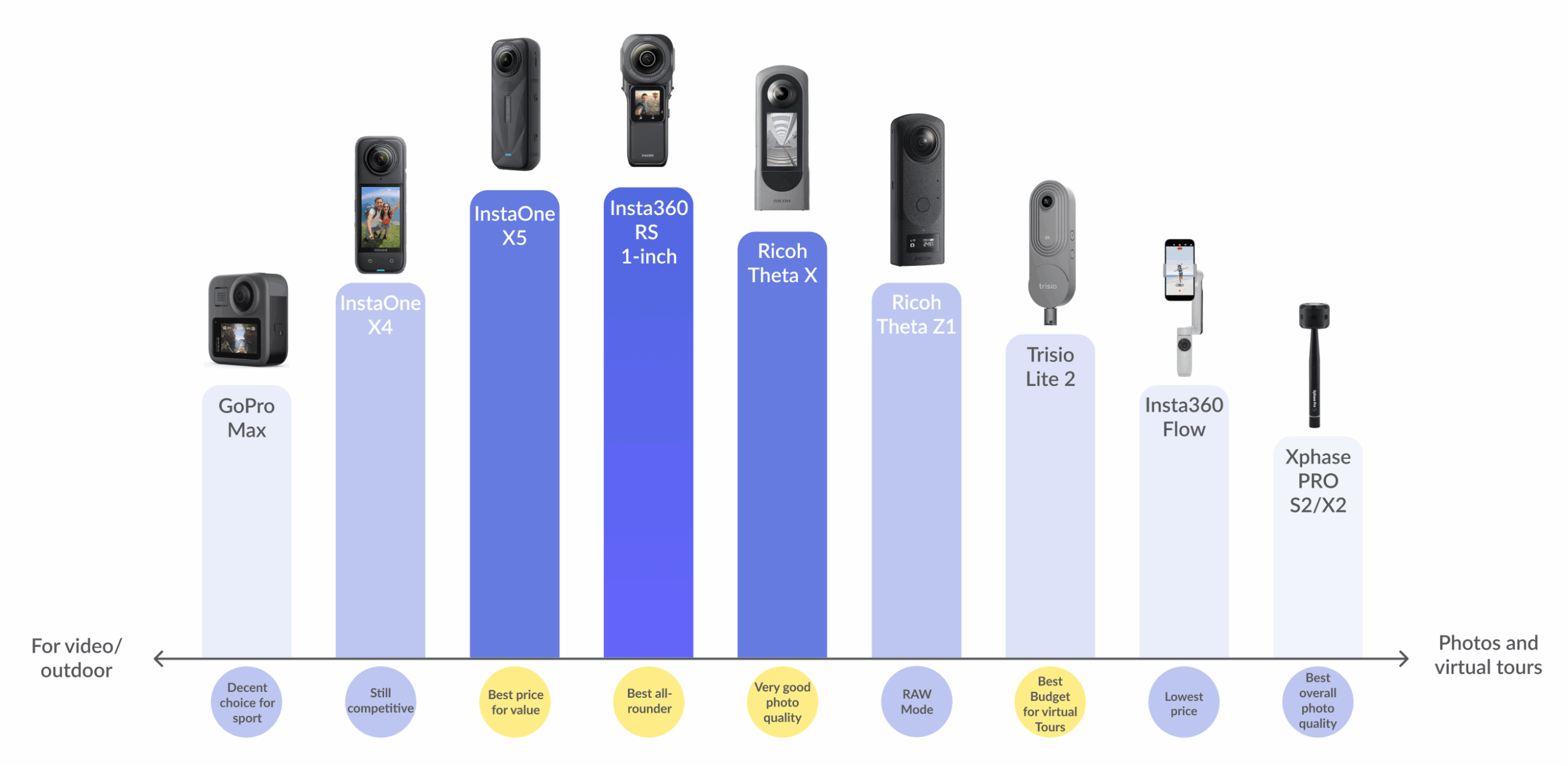
Unlike some other tech blog rankings, our best 360° cameras list is not affiliated with any 360° camera manufacturer. Our rankings are based solely on our experiences with the cameras and are thus 100% independent.
Three-sixty photography and videography are constantly evolving. As hardware becomes more and more accessible, it’s easy to get lost amid the plethora of options on the market.
We’ll start by giving an overview of the technology behind 360° cameras and follow up with a list of the best devices on the market in 2025.
Quickly jump to the camera review: Insta360 ONE X5 – Insta360 RS 1-inch – Insta360 ONE X4 – Trisio Lite 2 – Ricoh Theta X – Ricoh theta Z1 – Insta360 Flow – Gopro Max – Xphase pro S2/X2
A closer look at 360° cameras
What is a 360° camera?
Three-sixty cameras capture static scenes (360° photos) and innovative action sequences (360° videos), that cannot be shot with a conventional, 2D camera. No matter where you point the camera, you won’t miss any part of the surrounding environment because the capture is spherical. Hence the name 360° camera.
How does a 360° camera work?
Imagine the recorded scene, not as a flat rectangle, but as the inner surface of a sphere. When viewing a photo or video in a 360° player, you are looking out from the center of that sphere, navigating the inner surface by dragging the image. Try clicking and dragging the photo in the Panoraven player below.
That’s the software part, but how does the device physically capture this sphere? Three-sixty cameras, like traditional cameras, use flat sensors. But unlike their conventional counterparts, 360° cameras employ two back-to-back fisheye lenses, each capturing 180° of the environment. The camera then merges these two hemispherical images to produce a spherical view.
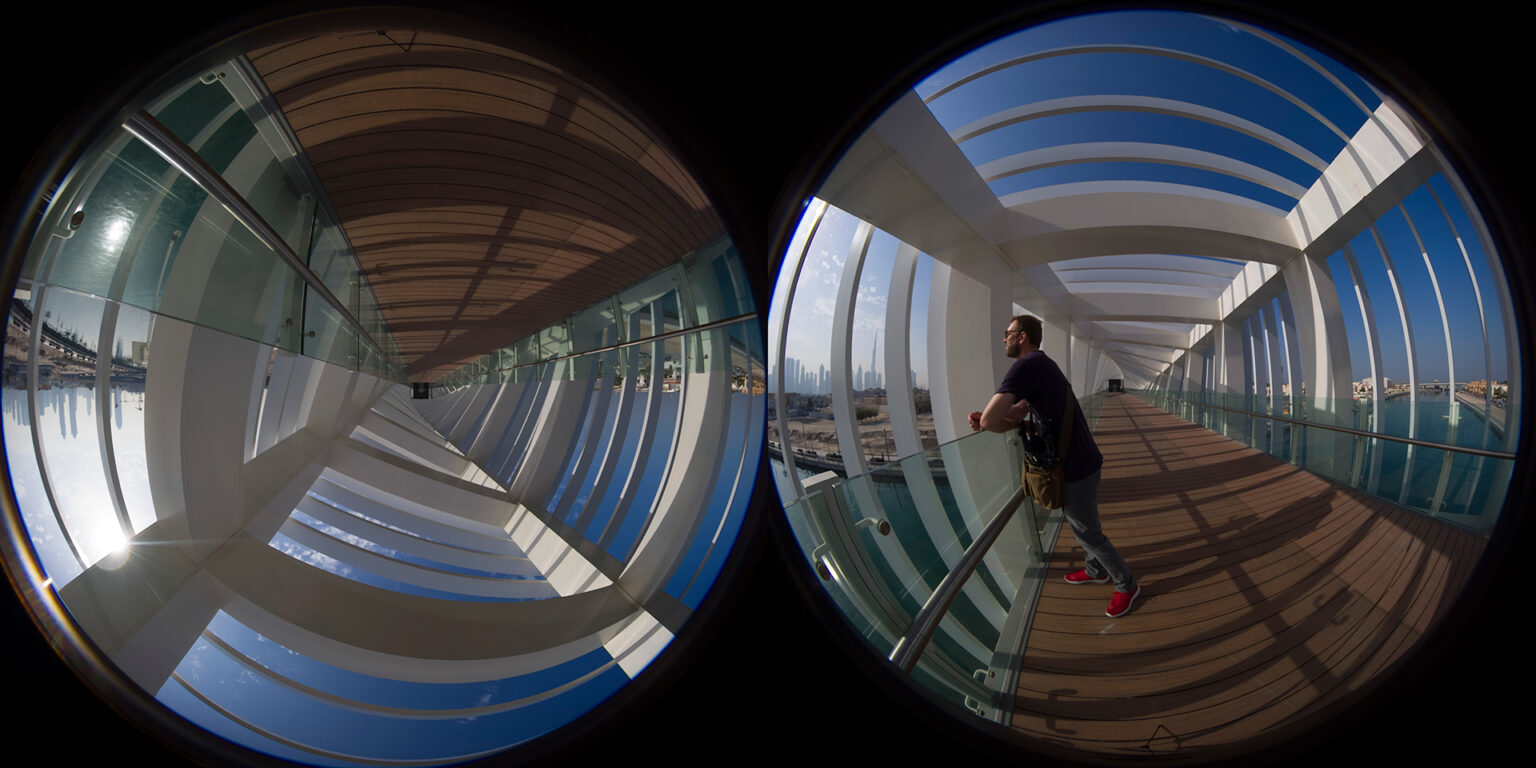
A 360° image is, by definition, static. You can navigate the image at will, focusing on any portion of the virtual environment.
360° videos are more sophisticated. While you have the freedom to watch any region, the action of the video continues regardless of your point of view. This means that it is possible to look in the “wrong” direction at a significant moment and miss the action that the videographer wanted to highlight. For this reason, we advise purchasing a photo rather than a video solution if your professional activity allows.
What does 360° technology offer your business?
Three-sixty cameras provide several shooting options. Quite popular are panoramic photos and videos, which are viewed through a specific player. Scroll up to see the player we are developing.
Three-sixty filming also affords a creative way to shoot classic “flat” videos. Recording the entire scene allows you to follow any subject during post-production. Since the camera covers all possible shots, you don’t need to frame the subject precisely, a definite advantage over a conventional camera.
These innovative cameras are revolutionizing the way companies present their products and services. Virtual tours of professional environments and simulated displays of merchandise are increasingly common. Want to leverage the technology for your business, but don’t know where to start? Read our guide to VR and 360° photography.
On the other hand, if you’ve already decided to invest in one of these technological gems, you’ve come to the right place. Our team specializes in 360° production, and we are passionate about our field. To understand what the market offered, we reviewed a slew of cameras that covered a range of applications.
This guide is the fruit of our in-house testing. (To deliver the best advice on this dynamic market, we regularly update our rankings [2025].) Without further ado, the best 360° cameras available today!
The best 360 cameras on the market right now
Insta360 One X5: the best 360° camera for the most
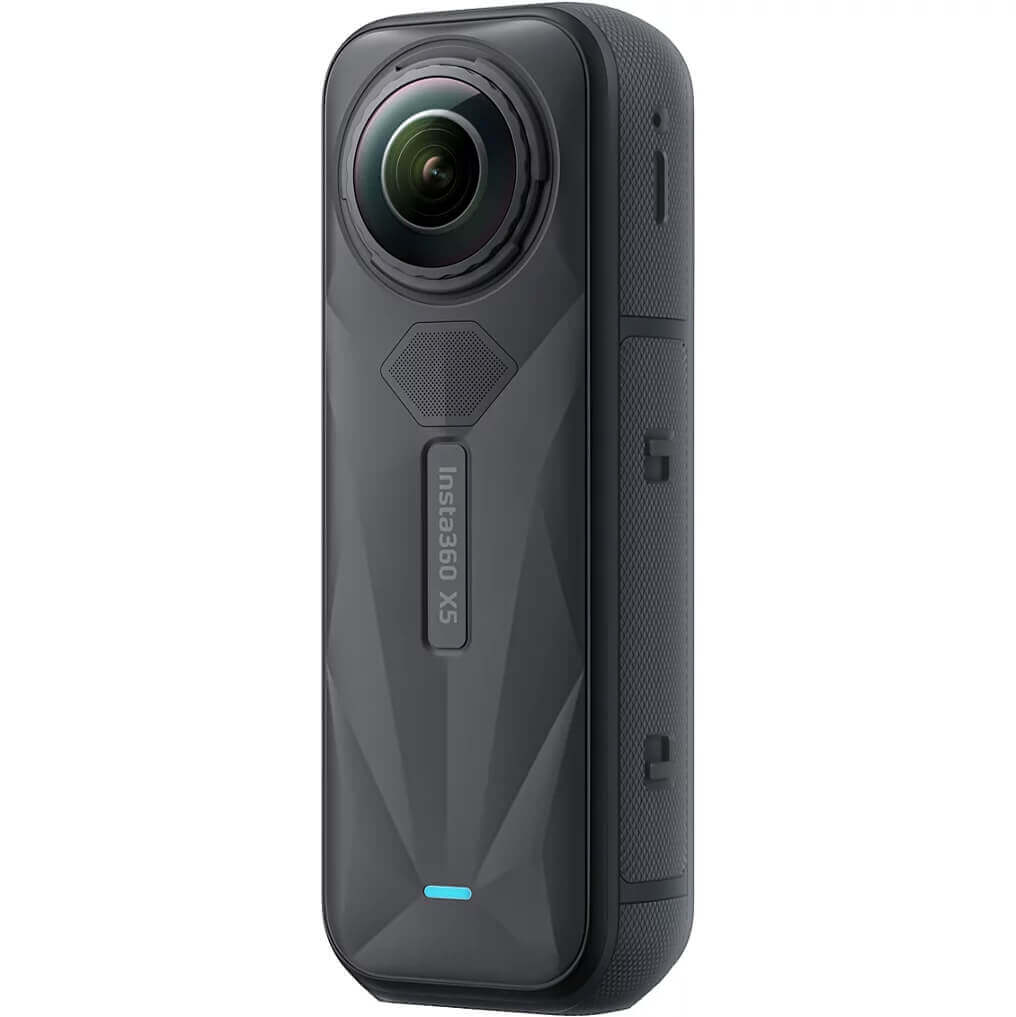
Insta360 One X5 is a no-brainer for newcomers.
Price: $550 | Weight: 200g | Dimensions :46×124.5×38.2mm | Waterproof: yes- 15m | Photo resolution: 72 MP (11904 x 5952) | Video resolution: 8K: 7680 x 3840 at 30/25/24 fps and 5.7K: 5760 x 2880 at 60/50/30/25/24 fps |Memory : SD card speed class UHS-I V30 max 1 TB recommended| Mount: 1/4″ tripod thread | Battery capacity: 2400 mAh (removable) = 88 min@8K | Charging time: 100% en 35min (9V 3A)
The Chinese leader in 360° cameras didn’t waste any time releasing its latest model. Launched in March 2025, the Insta360 ONE X5 follows the excellent Insta360 ONE X4 (released in late 2023).
As usual with Insta360, the X5 brings a significant technical upgrade, while staying true to the brand’s DNA: performance, compactness, and ease of use. At first glance, it looks like the X4, but it quickly sets itself apart with a series of improvements that push it a notch above, particularly for demanding users focused on image quality and long-term durability.
It’s the first time Insta360 includes a 1/1.28” sensor in such a compact body. This allows not only for a travel-friendly format but also a step forward in dynamic range, sharpness, and especially low-light performance.
In low-light or poorly lit indoor environments, the difference with the X4 (which had 1/2” sensors) is immediately noticeable, particularly thanks to the new PureVideo mode, powered by AI. It efficiently cleans up digital noise without degrading the image, making this camera especially attractive for professional content, where the X4 could hit its limits.
In terms of resolution, there’s no huge leap: the X5 records in 8K at 30 frames per second, just like the X4, but with more refined detail and better color accuracy. It also retains the 5.7K at 60 fps mode, ideal for smooth or sports footage. For photos, it still delivers 72 MP, the same as the X4, and more than sufficient for professional virtual tour results.
A long-awaited feature: the lenses are now replaceable. It may seem minor, but it’s a major change in the Insta360 ecosystem. The X3 and X4, while effective, had exposed, fragile lenses that were costly to replace. Here, not only are the lenses better protected, but they can finally be swapped out by the user. This feature significantly improves the camera’s durability in the field.
Another improvement: the battery has been increased to 2400 mAh, compared to 2290 mAh in the X4. This gives the X5 a comfortable battery life of around 185 minutes in 5.7K, a record for cameras in this category. As for waterproofing, that has also improved, going from 10 m (X4) to 15 m, without a case.
On the software side, Insta360 continues refining its interface. The InstaFrame function makes it easy to automatically generate a framed clip alongside the 360° video, simplifying the workflow for social platforms. The app also runs more smoothly, with an AI-powered editing mode that’s highly effective for creating dynamic content without requiring advanced technical skills.
If you’re new to 360° photography, the X5 is an obvious choice. It combines image quality, durability, and simplicity without compromise. For a first camera, it’s a no-brainer.
Should you upgrade from the X4 to the X5? That depends on your needs. If you’re already using the X4 mainly for daylight content, the differences will be subtle. However, if you’re looking to film in low light, optimize your professional workflow, or gain more confidence in the field (replaceable lenses, longer battery life, improved waterproofing), the X5 justifies its more premium positioning.
Compared to the RS 1-Inch, the X5 offers an interesting compromise. It delivers better resolution (8K vs. 6K), longer battery life, and a more practical all-in-one design for capturing action footage. On the other hand, the 1-Inch still holds a lead in extreme low light and high-end RAW photography thanks to its larger 1” sensors. If you’re primarily a photographer, the 1-Inch remains a safe choice. But for mixed, versatile, and video-oriented use, the X5 is the one to beat.
The Insta360 X5 impresses with the quality of its output, in both photo and video, meeting professional demands. Compact, rugged, and intuitive, it blends power and simplicity. For anyone ready to take 360° seriously, it’s an obvious choice.
| Advantages | Disadvantages |
| Excellent image quality, even in low-light conditions | Limited accessory compatibility (not compatible with X3/X4) |
| Versatile usage | |
| Great value for money | |
| Replaceable lenses |
Insta360 RS-1Inch: the high-level all-rounder
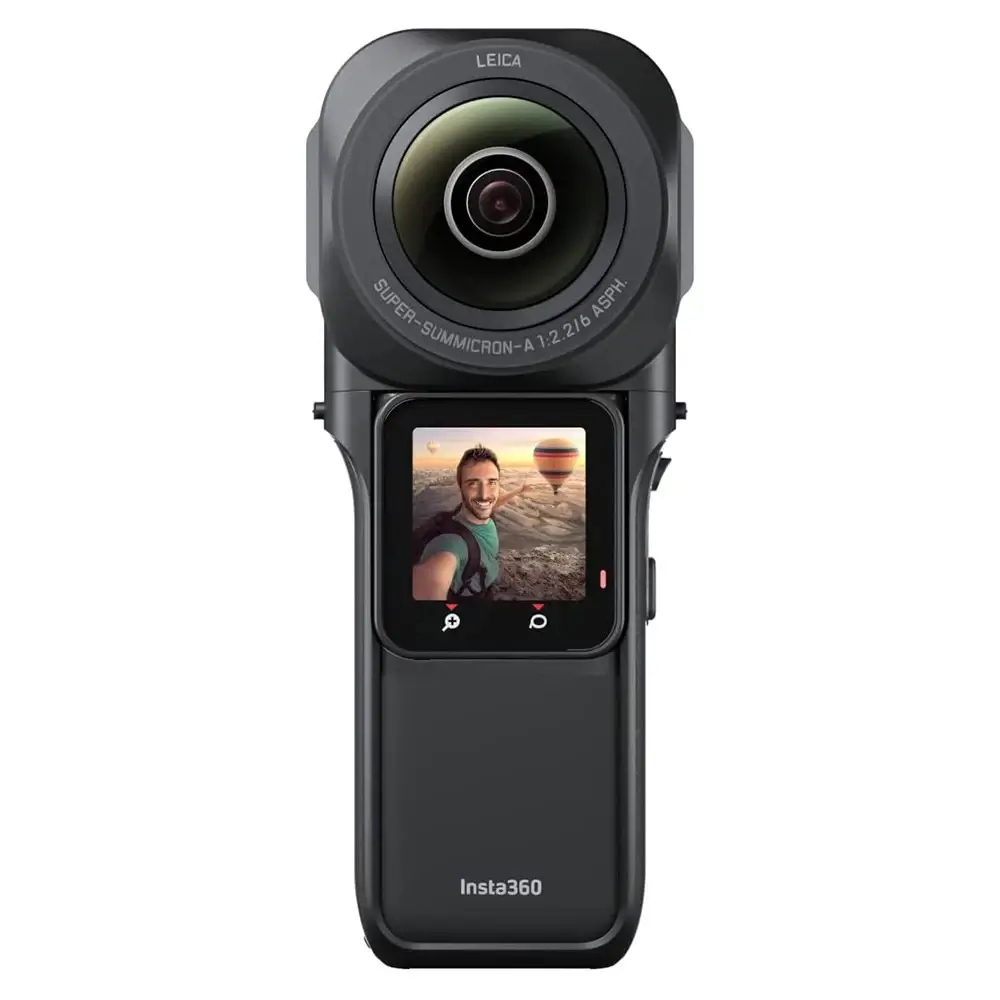
Price: $799 | Weight: 239g | Dimensions: 53.2×49.5×129.3mm | Waterproof: no (IP3) | Photo resolution: 6528×3264 (21MP) | Video resolution: 6K@25fps 3K@50fps | Memory: micro SD class V30 max 1TB| Mounting: Tripod Socket | Battery life: 1350mAh – 60 minutes in 6K@30ips video
Released in June 2022, the Insta360 RS 1-Inch is a 360° camera designed for those who seek flawless image quality, especially in photography or low-light environments. Although it’s part of the modular Insta360 RS series, it stands out from other modules thanks to its vertical format, more in line with the ONE X series.
Its main strength lies in its name: it houses two 1-inch Leica sensors, which are twice the size of those in the X3 and X4 (1/2”). To this day, only a few cameras like the Ricoh Theta Z1 offer a comparable sensor size, and that changes everything.
On paper, the resolution difference isn’t huge (6.1K vs 5.7K), but in practice, the result is noticeably cleaner, smoother, and faithful, especially in low light. Where smaller sensors generate noise, the RS 1-Inch maintains a natural and controlled image. This quality boost is evident in both video and photo.
The perceived quality often stands neck and neck with the X5, which delivers a sharper and more contrast-rich result. The RS 1-Inch, for its part, favors a more organic approach to image rendering, highly appreciated for virtual tours or projects with a realistic tone.
For stills, the resolution reaches 21 MP, but the larger sensors more than make up for the lack of pixels. The RAW mode is also available, offering solid noise control, balanced dynamic range, and impressive sharpness. It competes closely with the Theta Z1, Theta X, or Trisio Lite 2.
FlowState stabilization remains top-notch, and the built-in touchscreen makes navigation easier. Another rare feature: real-time video stitching, eliminating a common, time-consuming step in the post-production workflow — especially handy if you don’t have a powerful editing setup.
As for pricing, the RS 1-Inch sits around $799. It’s not an entry-level camera, but the performance-to-price ratio remains fair for those looking for a robust, durable tool focused on image quality.
While the newer X5 brings solid features (8K resolution, battery life, swappable lenses, InstaFrame…), the 1-Inch retains an edge in low-light performance and for demanding RAW workflows. It’s bulkier and less intuitive, targeting a different audience — those who prioritize pure image quality over portability.
The Insta360 RS 1-Inch remains a high-end benchmark for those who put image quality first. It won’t suit every user, but for professionals and advanced users, it’s a safe bet — and in some cases, a better choice than the X5.
| Advantages | Disadvantages |
| 1-inch sensors | Price |
| Excellent video/photo versatility | Difficult to remove the SD card (need to disassemble the modules) |
| Impressive low-light quality |
Insta360 ONE X4: Still a reliable choice in 2025
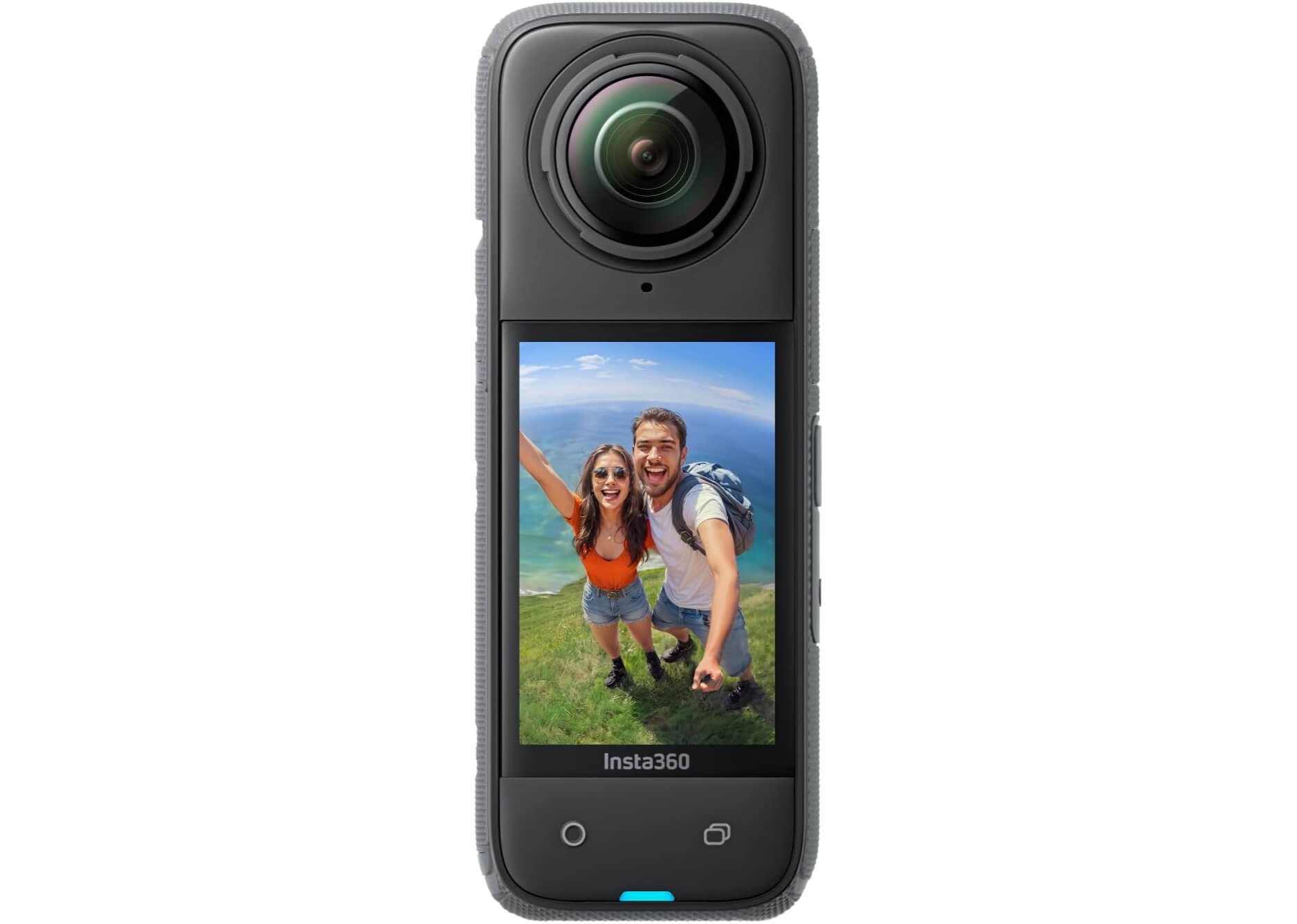
Price: $425 | Weight: 203g | Dimensions :46×123.6×37.6mm | Waterproof: yes- 10m | Photo resolution: 72 MP (11904 x 5952) | Video resolution: 8K: 7680 x 3840 at 30/25/24 fps and 5.7K: 5760 x 2880 at 60/50/30/25/24 fps |Memory :SD card speed class UHS-I V30 max 1 TB recommended| Mount: 1/4″ tripod thread | Battery capacity: 2290 mAh (removable) = 75 min@8K | Charging time: 100% en 55min (9V 2A)
Released at the end of 2023, the Insta360 ONE X4 marked a turning point in 360° capture, introducing 8K video in such a compact camera for the first time. Positioned between the X3 and the RS 1-Inch, it quickly established itself as a versatile model, equally suited for action videos and professional immersive photography. Even today, with the arrival of the X5, it remains highly relevant — especially for those seeking the right balance between performance, price, and simplicity.
Externally, the X4 closely follows the design of the X3, with a few subtle but thoughtful updates. It’s slightly thicker and longer, and now features a larger touchscreen (2.5” vs. 2.29” on the X3) and a 2290 mAh battery offering 75 minutes of 8K runtime — a notable improvement for this category.
Another welcome upgrade: clip-on lens protectors are now included. A simple but valuable improvement, especially considering how fragile the lenses are. These protectors stay firmly in place and do not interfere with stitching.
In terms of performance, the X4 records 8K at 30 fps, as well as 5.7K at 60 fps. It’s also waterproof up to 10 meters without a case, making it a great companion for outdoor or sports use.
For stills, resolution remains unchanged from the X3: 72 MP (11904 x 5952). This is more than enough for professional-grade results in virtual tours or panoramic imaging.
If you’re just starting out in 360° and find a well-priced second-hand X4, it’s an excellent choice. Its price-to-performance ratio is hard to beat, delivering clean images, intuitive handling, and a mature software ecosystem.
Against the newer X5, which is more expensive and includes larger sensors, swappable lenses, and better low-light performance, the X4 still makes sense for most standard use cases. The differences are noticeable but not decisive if you’re filming in daylight or controlled environments.
Compared to the RS 1-Inch, the X4 is more compact, easier to use, and better suited to mobile setups. The 1-Inch still leads in raw image quality, but at the cost of added bulk and complexity, which won’t suit everyone.
The Insta360 ONE X4 remains a solid pick in 2025. While it has been technically outpaced by the X5, it still offers an excellent balance between performance, price, and versatility. If you’re looking for a reliable, intuitive camera that can produce professional content without breaking the bank, the X4 deserves a spot on your shortlist.
| Advantages | Disadvantages |
| 8K video | The sound in video recording is rather disappointing |
| Versatility | |
| Value for money |
Trisio Lite 2 – Unbeatable value for money for virtual tours
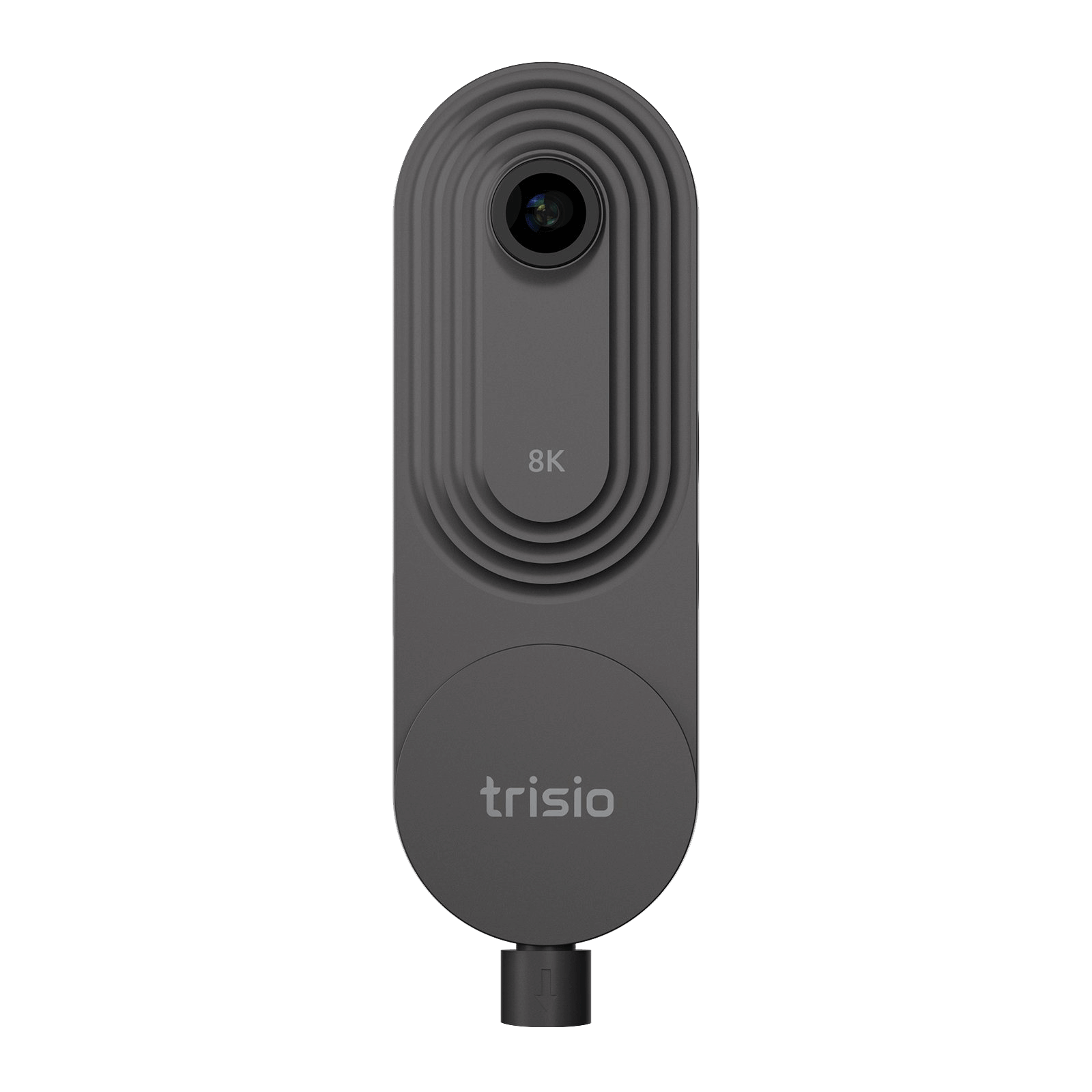
Price: $379 | Weight: 157g | Dimensions: 147 x 51 x 23mm | Waterproof: no | Still image resolution: 32 MP | Video resolution: does not make video | Memory: 7.1 GB internal – no micro SD | Mounting: Tripod Socket | Battery life: approximately 3 hours
Designed for the needs of virtual tour creators, the Trisio Lite 2 is exclusively dedicated to taking stabilized 360° photos. Unlike conventional 360° cameras, the Trisio Lite 2 does not have back-to-back lenses. It has one lens but has the particularity of being mounted on a motorized rotating part. Thanks to this, the camera turns on itself to take a set of 4 photos, then stitches them to create a single 360° photo.
This specificity makes it impossible to take 360° videos but gives serious advantages for 360° photography. Having only one lens allows the Chinese firm to display a competitive price compared to other cameras that have 2. Thus, the Trisio Lite 2 has a great price for 8K photo rendering ($379), giving it excellent value for money.
What’s more, where other cameras have to recompose the final 360° photo from just 2 photos, the Trisio Lite 2 has 4. This explains the quality of the images, comparable to those of the Theta X and the Theta Z1 which belong to a much higher price range ($599).
During our test, we liked its ease of use. The camera automatically analyzes the ambient light (AnyScene technology), shoots the 4 photos in HDR, and ensures no overexposed areas are in the final image. It will take 30 seconds per image unlike conventional cameras, which are faster. The recomposition of the 4 images is of very high quality and the stitching defects are almost invisible. It’s actually the best stitching we’ve seen out of all the 360° cameras tested. Image contrast is natural, accurate colors, and the dynamic range is excellent. Overall, the quality of the images is really there.
The main flaw of the Trisio Lite 2 is that there is no RAW mode. This will disappoint some for sure, but keep in mind that the output images are already of good quality. In addition, note that this is a con shared by Theta X.
On the hardware side, the storage capacity is built-in (no SD card) and 7.1GB (officially 8GB). This seems limited at first sight but knowing that a final photo is 4MB, you’ll be able to take 1,500-2,000 photos, which is quite reasonable.
The battery is also built-in: you cannot buy spare batteries. So you have about three hours of use ahead of you. One solution may be to use an external battery, but we found this annoying in practice because the camera needs to rotate to operate.
In conclusion, the Trisio Lite 2 is smartly designed to lower the manufacturing cost while optimizing the quality of the output images. It only does one thing: shoot stabilized 360° photos, but it does it exceptionally well. The photo quality is comparable to that of the Theta Z1, Theta X, and the Insta360 One X5. If you are a virtual tour professional, this is the best 360°camera in this price range.
| Advantages | Disadvantages |
| Very detailed 360° photo | No videos |
| Great stitching | No RAW |
| AnyScene mode (exposure calibration) | Few manual settings |
| Excellent value for money |
Ricoh Theta X – The best 360 camera for virtual tours
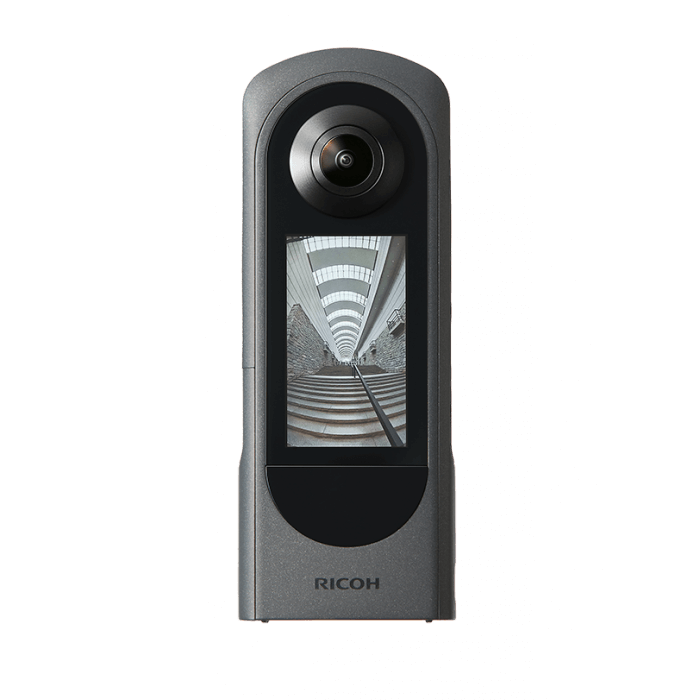
Price: $599 | Weight: 170g | Dimensions: 147 x 51 x 23mm | Waterproof: No | Resolution of still images: 11008 x 5504 – 60MP | Video resolution: 5.7K@30fps – 4K@60fps | Memory: MicroSD + 46Gb internal | Mounting: Tripod Socket | Battery life: 30 min in video mode – 200 photos
The Ricoh Theta X, released in the first quarter of 2022, is Ricoh’s new 360° camera. It follows the Theta Z1, which has become a reference for creating virtual tours.
The first thing you notice, which denotes its elders, is the presence of a touch screen on the camera. Large and responsive, it allows controlling the device and previewing images/videos without having to connect to the device.
Also, the battery is now removable, which allows for a simple solution during long work sessions, but we would have liked it to have a larger capacity, 1350 mAh being a bit tight (about 30 minutes of video or 200 photos). As for the storage capacity, the camera finally has a MicroSD slot to complete its internal 46GB memory. These show that Ricoh, which had previously focused on photo quality, makes the Theta X more versatile and better equipped for video.
The Theta X has two sensors of 1/2 inch each, thanks to this it can take 360° photos with a resolution of 60MP. Overall this gives good-quality photos, which are sharp and dynamic. Indoors, the camera is able to reduce overexposure and capture plenty of detail with auto-HDR mode. On the other hand, the colors can sometimes appear dull and, unlike the Z1, the Theta X does not have a RAW mode to correct these color defects. However, it is possible via the touch screen to manually adjust the bit rate, ISO, shutter delay, and exposure.
Ricoh has never designed its cameras with video in mind first. That said, this device is now capable of taking videos, 25 min max, in 5.7k@30fps or 4K@60fps. The camera, therefore, aligns with this point on the Insta One X4. On the other hand, the quality of stabilization, unchanged since the Z1, is still below the competition. You will not be able to use the Theta X as an Action Cam. The camera also has an image stitching feature built into it. You will not have to recompose them via software afterward: this considerably reduces the processing time.
The Theta Z1 takes better quality images than the Theta X in terms of looks, thanks to the 1-inch sensors and RAW mode. That said, the workflow to get the best quality images for the Z1 is much longer than for the Theta X; you can get around 80% of the quality with the Theta X in half the time. Honestly, the JPEGs output from the Theta X is very good and the RAW will only miss the purist.
In conclusion, the Theta X is an excellent choice for the creation of static virtual tours. The Theta Z1 is capable of outputting slightly higher-quality images, but at the cost of a heavier workflow. As a purist, you will prefer the Z1. For others, the Theta X will be an excellent choice.
| Advantages | Disadvantages |
| Very detailed images | No RAW mode |
| Multitudes of settings | Battery capacity is a bit tight |
| Excellent auto-HDR mode | Lenses sensitive to glare |
| Large touch screen to preview and adjust |
RICOH THETA Z1: the choice for pro photography
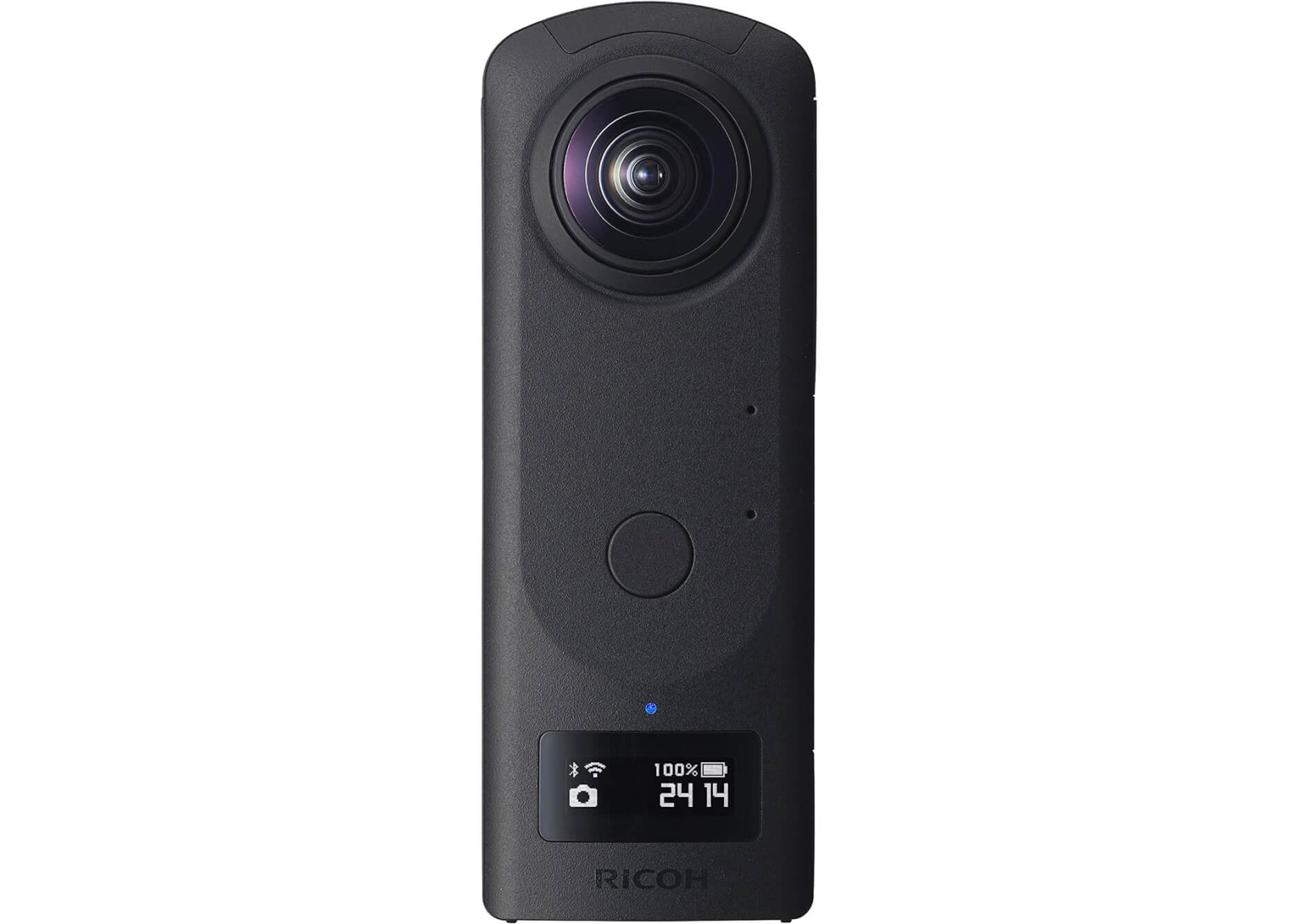
Price: $ 1045 | Weight: 182 g | Dimensions: 133 x 48 x 30 mm | Waterproof: No | Photo resolution: 6720 x 3360 | Video resolution: 4K | Memory: 19 or 51 GB | Mount: Tripod socket | Battery life: Approximately 60 minutes
Released in 2019, the Ricoh Theta Z1 is still competitive in 2025 and deserves its place in our ranking. The camera has since benefited from an update increasing the internal memory from 19 GB to 51 GB in May 2021. In March 2022, Ricoh released the Theta X (tested above), which is a more accessible camera but lacks some functions that the Z1 has. The Theta Z1 is therefore still an option that you can consider in 2025.
The Theta Z1 can capture 23MP (6720 x 3360 px) photos and 4K videos, but the image quality is much greater than these numbers suggest. Thanks to its 1-inch sensors – larger than other 360° cameras – the Z1 shoots high-resolution photos and videos with excellent dynamic range.
No doubt, photo quality is the crowning glory of the Theta Z1. Compared to other 360° cameras, the Z1 produces better raw photos and gives you more control over the exposure. Under low light conditions, it is superior to other models. In fact, we prefer the Z1 over the X, which has a higher resolution on paper, precisely because the Z1 is more reliable in terms of photo rendering, especially in low-light situations.
But the Theta Z1 has one drawback: the price. At $1045, it remains too expensive for most amateurs. Moreover, the camera has not decreased in price since its release six years ago. Logic would have the Z1 be more accessible ($200-$300 less), and we regret that this is not the case.
The Theta Z1 still benefited from an increase in its internal memory (51GB), but it suffered from its size (19GB). This equips it slightly better for video, but the camera isn’t waterproof, and the stabilization is far from optimal. Overall, like all Ricohs, it’s not designed for video, and you won’t be able to take good outdoor action shots with it. If you want to use it in this context, we prefer the Insta360 One X5.
If you have the budget and are looking to capture professional 360° photos (e.g., for virtual tours), you may want to consider investing in the Ricoh Theta Z1 or the Theta X. If your top priority is the quality of photography and consistency of output, these cameras remain solid choices in 2025. However, it’s worth noting that we’re disappointed that the price hasn’t changed since its release (5 years ago), which affects their competitiveness against more recent competitors on the market.
| Advantages | Disadvantages |
|---|---|
| Exceptional photo quality | High price tag |
| Auto HDR mode | Built-in 51GB memory – no Micro SD slot |
| RAW mode | Non removable battery |
Insta360 Flow: The low-cost choice to pair with a smartphone

Price: $109 | Weight: 400g (14.1oz) | Dimensions: Folded = 3.1 x 6.4 x 1.4 in Unfolded = 2.9 x 10.6 x 2.8 in | Waterproof: no | Compatible phone thickness: 0.3 – 0.4 in | Compatible phone width: 2.5 – 3.3 in | Battery capacity: 2900mAh = approx. 12 hours | Charging Time: 2 hours (5V/2A)
The smartphone stabilizer market is abundant, with the Insta360 Flow emerging in a field initially established by brands like DJI, Zhiyun, and Feiyutech. Despite its competitors’ lead, Insta360 Flow stands out with innovative features, especially its ability to take 360° photos, a first for stabilizers.
In our comparative review of 360° cameras, we’ll focus specifically on this feature. For those interested in other aspects of the device, a more general review can be found here.
Design-wise, the Insta360 Flow is well-crafted, with a simple and effective stabilizer deployment mechanism, and compactness when folded, making it highly portable. The build quality feels robust, capable of withstanding shocks during use or transport. It includes a removable magnetic clamp for quick smartphone attachment.
Setting up is easy, with the option to place it on the ground using the hidden mini-tripod in the handle or on an external tripod via a mounting thread also on the handle. The process takes only a few minutes.
Insta360 Flow creates 360° photos by rotating the smartphone on three axes and taking shots in each direction to cover the entire surrounding area. Like the Trisio Lite 2, it shoots only 360° photos (no 360° videos).
To start capturing, just select the “panoramic” mode in the Insta360 app (available for Android and iOS). Once the shooting process finishes, the app stitches the photos together to form a 360° image, which is then initially saved on the smartphone and can be exported for further editing.
The fundamental difference from other 360° cameras is that photo quality depends on the smartphone’s lens quality. This means the Insta360 Flow’s image quality can improve with smartphone upgrades, without needing a new stabilizer.
We tested the Insta360 Flow with an iPhone 15, which has high-end lenses. To give an idea of the output quality, we compared its results with the Trisio Lite 2, its direct competitor (low budget – 360° photography).
Although not matching the image quality of specialized 360° cameras, the Insta360 Flow remains a suitable option for those with modern smartphones, yielding quality that is suitable for professional scenarios with moderate requirements.
As for battery life, it impresses with its good 12 hours of autonomy, and a bonus feature is its ability to charge your smartphone.
The Insta360 Flow is a cost-effective and multifunctional tool that allows you to capture decent quality 360° photos, provided you have a modern smartphone. However, if you’re constrained by a budget but aspire for higher image quality, we recommend you choose the Trisio lite 2.
| Advantages | Disadvantages |
|---|---|
| Price | No 360° video capture |
| Practical and robust | Inferior 360° photo quality compared to dedicated devices |
| Versatility |
GoPro MAX – The camera for outdoor and sportive shooting
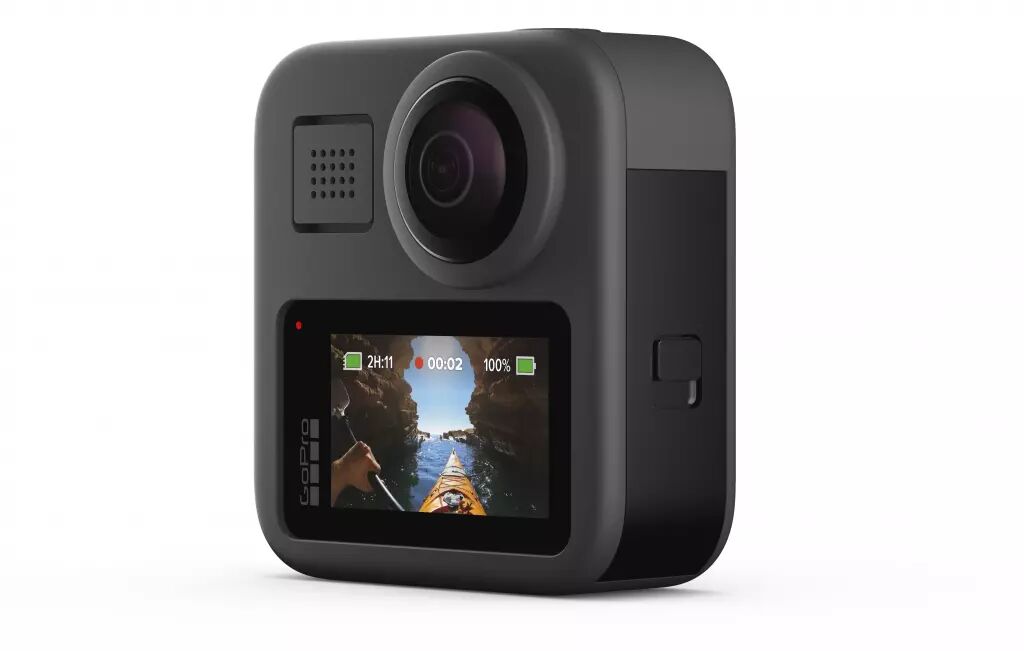
Price: $399 | Weight: 115 g | Dimensions: 25 x 64 x 69 mm | Waterproof: Yes | Photo resolution: 18 MP | Video resolution: 5.7K | Memory: MicroSD (not included) | Mount: Tripod socket | Battery life: 85 minutes
If you’re looking to film immersive videos of outdoor adventures or sports escapades, then the GoPro Max remains a viable option in 2025.
The GoPro Max is waterproof down to five meters (16.5 feet) without a case, and the editing workflow through the app is relatively straightforward. If you want to turn your 360° video into a traditional 2D movie – one of the innovations facilitated by 360° cameras – the app’s OverCapture software makes the job easy.
The GoPro Max expands many features of the GoPro Hero 8 Black (its predecessor), including HyperSmooth stabilization and 360° TimeWarp footage. Qualitatively, the photo and video results are slightly poorer than those of other contenders in this ranking. If you want to do 360° photography like virtual tours, we advise you to turn to other models like the Insta360 RS-1inch or the Insta360 One X4.
On the other hand, the GoPro Max is solid and waterproof. Equipped for sports outings, it frees you to capture the drama of the moment without sweating over the direction of the shot or the integrity of your device.
It is still possible to obtain good results with the GoPro Max, which is addressed to sportsmen and outdoor adventurers. For the others, its average quality in low light and its general photo quality (however correct) should lead you to another model, like the Insta360 One X5. Indeed, even if the GoPro Max still has cards to play, it does not seem to be a priority for GoPro, which has stopped its development. At the price of new, there is a better investment to make, in our opinion.
| Advantages | Disadvantages |
|---|---|
| Ease of editing via the app | No traditional 4K capture |
| Robust design | Inferior performance in low light |
| Waterproofness to 5 m without a shell |
Xphase pro S2/X2 – Unrivaled photos sharpness, suffers from a heavy workflow
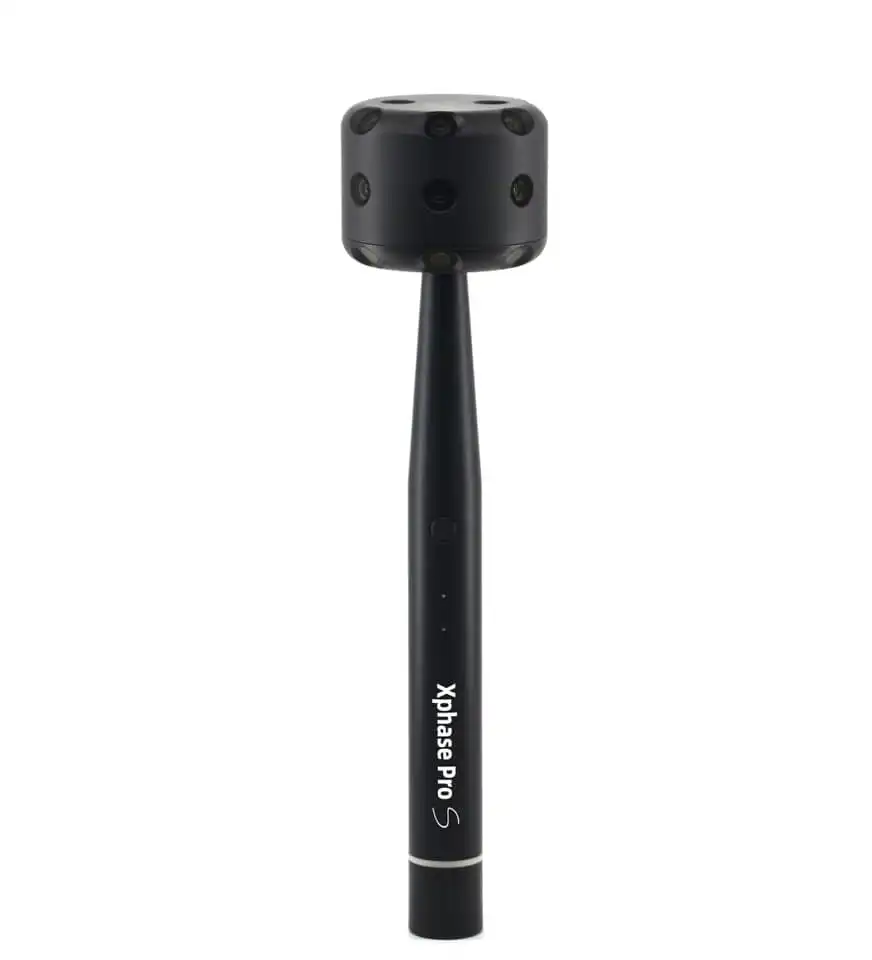
Price: $979 | Weight: 248g | Dimensions: camera diameter = 60mm; handle diameter = 22mm and height = 245mm | Waterproof: No | Photo resolution: 16384 x 8192 (134mp) | Video resolution: None (no video) | Memory: USB removable (32GB included but can be changed)
In 2020, when the Xphase pro S was released, it was the first “one button shoot” 360° camera capable of such high-resolution photos (134 MP = 16K). Thanks to its 25 lenses of 1/3.2 inches mounted on a cylindrical body of 60 mm, the camera has all that it takes to delight virtual tour creators.
However, we were not convinced by the camera from the Chinese firm even if the photo sharpness was unequaled, the Xphase PRO S suffered from too many issues. For example, the dynamic range was average compared to what the Theta Z1 can do; the nadir and zenith suffered from distortions related to stitching issues; the Wi-Fi link between the camera and its application randomly dropped out, etc.
The good news? In 2025 these major problems have been solved by the release of a new version: the Xphase PRO S2/X2. The colors are much better, and we can finally appreciate the incredible sharpness of the 25 stitched shots. Consequently, the new version of this camera has its place in our ranking because it is now unrivaled in terms of photo quality. Indeed, no other camera in the market does a better job in this area.
That being said, even if a lot of problems have been solved between the two versions, the image editing process is still reserved for experts. The workflow is anything but intuitive, and it will take some time to master the camera effectively.
Note that the Xphase pro-S2 does not take video. It is also particularly addressed to virtual tour creators. With the camera being quite long to set up, it is not suitable for cases in which you have to take pictures on the spot (selfies, etc.). It is more suitable in situations where you can take your time, typically during the creation of virtual tours.
The battery allows you to take about 50 photos, which may not be enough in some cases. Therefore, don’t forget to bring an external battery for a prolonged shooting session. The storage is USB-based, with a provided 32GB key. It is possible to increase its capacity (be sure to check its compatibility first, because the key is positioned in the handle, and thus has a particular size to fit into it).
For editing, you will also need a high-end computer to process the photos. The output photos are 250 MB each, and the color correction manipulations from software like Photoshop will be greedy in RAM (we recommend 32 to 64 GB of RAM as well as a good graphics card).
It is true, it sounds like a lot of drawbacks. But still, the photo quality of the Xphase PRO S2/X2 is excellent and much sharper than the competition. This remains a great advantage that justifies considering buying it.
The Xphase PRO S2/X2 trades its exceptional resolution for a long and complex workflow. Experts in virtual tour creation should take a closer look at it, but we recommend others to search for a more user-friendly 360° camera.
| Advantages | Disadvantages |
|---|---|
| Unrivaled 360° photo sharpness (16K) | No video capture |
| Long and complex workflow | |
| Not enough battery |
A few additional models to mention
360° and 3D hybrid models

For 360° shooting, you can ignore these cameras. Their quality doesn’t come close to the standard. But for 3D imaging, consider the Vuze XR, which offers good value for the money.
The best 360 cameras of 2025: Wrapping up!

Insta360 RS 1-Inch and X5 are now in the same league: two high-end cameras, close in quality but designed with different priorities. RS 1-Inch will appeal to photography purists, those who shoot in RAW or seek a more organic image, especially in low light. X5, on the other hand, stands out for its compactness, versatility, and excellent price-to-performance ratio — ideal for video content creators.
With a tighter budget, the ONE X4 remains a very relevant option: it still offers great image quality and strong battery life, making it ideal for action, creative, or hybrid use.
For virtual tour professionals, the Trisio Lite 2 remains a strong contender in terms of value. And if you have a recent smartphone, Insta360 Flow may be enough in specific cases.
Lastly, for photo-first 360° use, Theta Z1, Theta X are serious alternatives. The choice depends largely on your post-production habits: RAW optimization with the Z1, and compact design with the Theta X.
And for those seeking the best sharpness, the XPhase PRO S2/X2 remains a compelling option, as long as you’re comfortable with a more technical workflow.
Hi!
Great article, it really helps that your ranking is based on experience and not on partnerships with camera manufacturers.
Just a quick question, I was about to buy the Insta360 ONE X2 but saw some reviews stating that you need a high end smartphone for it to work, and that it has some issues with Android phones, I’m just worried it won’t work on my cellphone, would you recommend getting the Kandao QooCam 8K instead? I’m not planning on using it for business applications, just taking vacation videos to watch them later on VR.